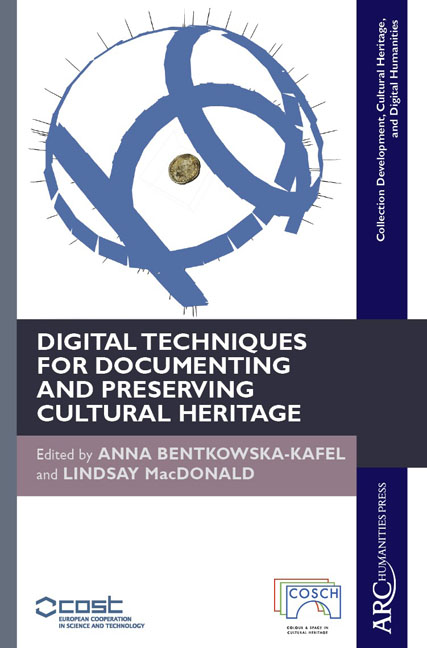Reflectance Transformation Imaging
Published online by Cambridge University Press: 26 January 2021
Summary
COSCH Case Studies that have employed this technology: Roman coins, Germolles (H-RTI)
Definition
Reflectance Transformation Imaging (RTI) is a family of methods for modelling the distribution of light reflected from an object surface as functions of space, angle, spectrum, and time. One instance is the Polynomial Texture Mapping (PTM) technique, which enables the visualization of relief surfaces under a variable lighting direction.
Description
Malzbender et al. (2001) introduced PTM as a novel image-based relighting technique, which takes a set of digital images of an object, all captured from a fixed camera position, each lit by a point source at a different but known coordinate position. Malzbender designed and built the original apparatus at HP Labs, Palo Alto, California, from an acrylic hemisphere of diameter 18 inches (45 cm) with twenty-four flash lights. He demonstrated the power of the PTM technique for the visual representation of objects with surface relief, such as fossils and inscribed clay tablets.
The PTM algorithm fits a biquadratic function (two-dimensional parabola with six parameters) to the set of intensities at each pixel location. The interactive viewer software then uses the cursor position, representing the geometric coordinates of a virtual light source, to generate the intensity of each pixel as if it had been illuminated from that direction. A separate set of six coefficients is fitted to the image data for each pixel and stored as a spatial map, which has the same spatial resolution as each of the original n images, but has a low resolution in the angular space of the incident illumination, because the n directions of the image set are approximated by only six coefficients at each pixel. An improved set of basis functions, known as hemispherical harmonics (HSH), was introduced by Gautron et al. (2004), which gives a better estimation of intensity as a function of angle, at the expense of additional parameters. The interactive control of lighting direction in the viewer software facilitates perception of the surface structure compared to static photographs, thereby enhancing the legibility of surface relief and inscriptions. The visual effect is of a virtual torch moving over a static 3D object surface, although there is no inherent 3D geometry.
- Type
- Chapter
- Information
- Publisher: Amsterdam University PressPrint publication year: 2018



